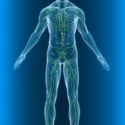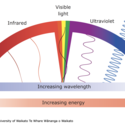The Earth’s atmosphere1 blocks most of the Sun’s UV radiation2 from penetrating through the atmosphere. The small amount that gets through has both positive and negative effects.
Positive (beneficial) effects of UV
Triggers vitamin D – UV from the Sun is needed by our bodies to produce vitamin D. Vitamin3 D helps strengthen bones, muscles and the body’s immune system4. It may also lower the risk of getting some kinds of cancers such as colon5 cancer6.
Helps some skin conditions – UV is used in the treatment of skin conditions7 such as psoriasis. This is a condition8 where the skin sheds its cells too quickly and develops itchy, scaly patches. Exposure to UV slows the growth of the skin cells and relieves the symptoms.
Helps moods – Research suggests that sunlight stimulates the pineal gland in the brain to produce certain chemicals9 called ‘tryptamines’. These chemicals improve our mood.
Helps some animals’ vision – Some animals (including birds, bees and reptiles) are able to see into the near UV light10 to locate many ripe fruits, flowers and seeds that stand out more strongly from the background. The fruits, flowers and seeds often appear quite different from how humans see them. For example, when seen in UV light, some flowers have different line markings, which may help direct bees and birds to the nectar11.
Aids some insects’ navigation – Many insects use UV emissions from celestial objects as references for navigating in flight. This is why a light sometimes attracts flying insects by disrupting their navigation process.
Useful for disinfection and sterilisation – UV has positive applications in the fields of disinfection12 and sterilisation. UV can effectively ‘kill’ (deactivate or destroy) microorganisms13 such as viruses and bacteria14, for example, when hanging cloth nappies, underwear and tea-towels outside on the clothesline. To destroy the microorganisms, UV rays penetrate the cell's membrane15, destroying the DNA16, and so stops its ability to reproduce and multiply. This destructive effect explains why we can use UV antibacterial17 lamps for disinfection and sterilisation. Mangere Wastewater Treatment Plant in Auckland use UVC light to disinfect wastewater.
Negative (harmful) effects of UV
Causes skin cancer – UV is an environmental human carcinogen18. It’s the most prominent and universal cancer-causing agent in our environment. There is very strong evidence19 that each of the three main types of skin cancer (basal cell20 carcinoma21, squamous cell carcinoma and melanoma22) is caused by sun exposure. Research shows that as many as 90% of skin cancers are due to UV radiation.
Causes sunburn – UV burns the skin. Sunburn is a burn that occurs when skin cells are damaged. This damage to the skin is caused by the absorption of energy from UV rays. Extra blood flows to the damaged skin in an attempt to repair it, which is why your skin turns red when you are sunburnt.
Damages immune system – Over-exposure to UV radiation has a harmful suppressing effect on the immune system. Scientists believe that sunburn can change the distribution and function of disease-fighting white blood cells in humans for up to 24 hours after exposure to the sun. Repeated over-exposure to UV radiation can cause even more damage to the body's immune system. The immune system defends the body against bacteria, microbes, viruses, toxins and parasites23 (disease24 and infection25). You can see how effective the immune system is by looking at how quickly something decays when it dies and the immune system stops working.
Damages eyes – Prolonged exposure to UV or high intensities of UV (for example, in sunbeds) damages the tissues of eyes and can cause a ‘burning’ of the eye surface, called ‘snow blindness’ or photokeratitis26. The effects usually disappear within a couple of days, but may lead to further complications later in life. In 1998, the Journal of the American Medical Association reported that even low amounts of sunlight can increase the risk of developing eye damage such as cataracts (which, left untreated, will cause blindness), pterygium and pinguecula. UV damage to the eyes is cumulative27, so it is never too late to start protecting the eyes.
Ages skin – UV speeds up the aging of skin, since the UV destroys collagen28 and connective tissue beneath the top layer of the skin. This causes wrinkles, brown ‘liver’ spots and loss of skin elasticity29. The difference between skin tone, wrinkles, or pigmentation30 on the underside of a person's arm and the top side of the same arm illustrate the effects of sun exposure on skin. Usually, the top side of the arm has had more exposure to the sun and shows greater sun damage. Because photo-aging of the skin is cumulative, it is never too late for a person to start a sun protection programme. Otherwise, though a tan may look good now, you could be paying for it with wrinkly leathery skin or skin cancer later.
Weakens plastics – Many polymers used in consumer31 items (including plastics, nylon and polystyrene) are broken down or lose strength due to exposure to UV light.
Fades colours – Many pigments (used for colouring food, cosmetics, fabric, plastic32, paint, ink and other materials) and dyes absorb UV and change colour. Fabrics, furnishings and paintings need protection from UV (fluorescent lamps as well as sunlight) to prevent colour change or loss.
Nature of Science
The role of science is to provide the best understanding of the world at the moment. This understanding is important so that we can best decide how to use this information.
Useful link
For more information UV exposure and health visit the Environmental Health Indicators New Zealand website.
Get to know your melanocytes, the cells responsible for producing melanin33 pigments that protect the body from the adverse34 effects of UV-B light exposure. This article is from Biology Online.
- atmosphere: 1. The layer of gas around the Earth. 2. (atm) A non-SI unit of pressure equivalent to 101.325 kPa.
- radiation: Energy that is transmitted (radiates) from a source in the form of rays or waves or particles.
- vitamin: An organic compound required as a nutrient in tiny amounts by an organism.
- immune system: The natural defence system found in living things. In humans, a network of organs, cells and proteins that helps to protect us against anything it recognises as being an ‘invader’ or ‘foreign’, for example, bacteria, viruses, cancer cells, parasites and transplanted organs and tissues. In plants, a network of disease resistance genes enable plants to detect and resist things like fungi, bacteria, viruses, nematodes and insects.
- colon: That part of the large intestine between the caecum and rectum. It consists of four sections: the ascending colon, the transverse colon, the descending colon and the sigmoid colon.
- cancer: The term for a group of more than 100 diseases in which abnormal cells divide and multiply uncontrollably.
- condition: An existing state or situation; a mode or state of being.
- condition: An existing state or situation; a mode or state of being.
- chemicals: Everything is made up of chemicals. All matter (anything made of atoms) can be called chemicals. They can be in any form – liquid, solid or gas. Chemicals can be a pure substance or a mixture.
- UV (ultra violet) light: Light that is invisible to the human eye and at a wavelength between 300–400 nanometres. UV light is what causes sun burn and can cause some types of cancer.
- nectar: A sugary liquid found in many flowers, made and stored in a nectary. Used to attract animals, which eat it and accidentally collect or deposit pollen at the same time.
- disinfection: When a substance is applied to a non-living surface in order to kill microorganisms.
- microorganism: A living organism which is too small to be seen with the naked eye and can only be observed using a microscope. Includes bacteria and most protists.
- bacteria: (Singular: bacterium) Single-celled microorganisms that have no nucleus.
- membrane: An enclosing layer that acts as a selective barrier around a cell.
- DNA: Deoxyribonucleic acid (DNA) is a molecule that contains the instructions needed for an organism to develop and function. These instructions are stored as a code made up of four chemical bases: adenine (A), guanine (G), cytosine (C) and thymine (T).
- antibacterial: A substance that can kill or prevent the growth of bacteria.
- carcinogen: A substance that can cause cancer.
- evidence: Data, or information, used to prove or disprove something.
- cell: 1. Building block of the body. A human is made of millions of cells, which are adapted for different functions and can reproduce themselves exactly. 2. A simple electrolytic device that enables chemical energy to be transformed into electrical energy.
- carcinoma: Any malignant cancer that begins in the cells that cover or line an organ (including skin). Carcinomas invade surrounding tissues and organs and may metastasise (spread) to lymph nodes and other sites.
- melanoma: A cancer of a particular type of skin cell, called a melanocyte. Melanocytes are responsible for skin colour. The cancer usually appears on the skin, but may affect the eye and membranes (for example, the lining of the nose, the meninges of the brain or the lining of the anus).
- parasite: An organism that lives in or on another organism. Parasites usually cause harm to their host organism.
- diseases: 1. An abnormal condition of an organism that impairs bodily functions. 2. In plants, an abnormal condition that interferes with vital physiological processes.
- infection: Invasion of the body or a species by something that could be harmful or cause a disease.
- photokeratitis: A painful eye condition caused by too much light burning the cornea, for example, from using a welder’s torch or tanning beds without eye protection. Feels like having sand poured into the eyes.
- cumulative: Gradually building up.
- collagen: Any of various tough, fibrous proteins found in bone, cartilage, skin, and other connective tissue. Collagens have great strength and their job is to form strong insoluble fibres that connect cells. Collagen is converted into gelatin when it is boiled.
- elasticity: The ability of a solid to return to its original shape or form after it has been stretched or compressed.
- pigment: Any fine, insoluble, dry, solid particles used to give colour. In biology, the dye-like material produced generally in the superficial parts of animals that gives colour to skin, eyes and hair.
- consumer: 1. An organism that feeds on other organisms to obtain energy for life processes. These organisms are also called heterotrophs. 2. A person who purchases goods and services for personal use.
- plastic: A synthetic material made from a wide range of organic polymers (such as polyethylene, PVC and nylon) that can be moulded into shape while soft and then set into a rigid or slightly elastic form.
- melanin: The black or dark brown pigments present in the hair, skin and eyes of humans and animals. It is produced in excess in certain skin diseases and in melanomas. People with dark skin have more melanin than people with fair skin.
- adverse: Unfavourable or contrary.









